Risk Management System Report: Airline Company Operations Analysis
VerifiedAdded on 2022/11/14
|10
|2124
|214
Report
AI Summary
This report outlines a comprehensive risk management system (RMS) designed for a new international airline operating from Australia. The RMS addresses critical aspects such as the use of second-hand aircraft, leased facilities, and passenger handling. The report discusses the importance of RMS in mitigating potential risks and ensuring operational safety, especially in the aviation sector, which includes hazard identification, risk assessment, and risk mitigation. The integration of corporate governance, implementation of CRM, and a safety management system are highlighted. The report also covers essential elements of RMS, including hazard identification, risk assessment, and mitigation strategies. Furthermore, it addresses director's and officer's liability, aviation enterprise insurance, and insurance claims. The conclusion emphasizes the need for a robust safety culture, proper maintenance, and internal control systems to achieve both customer satisfaction and productivity. The report provides a detailed analysis of each element, offering insights into the development of a successful RMS for the airline.
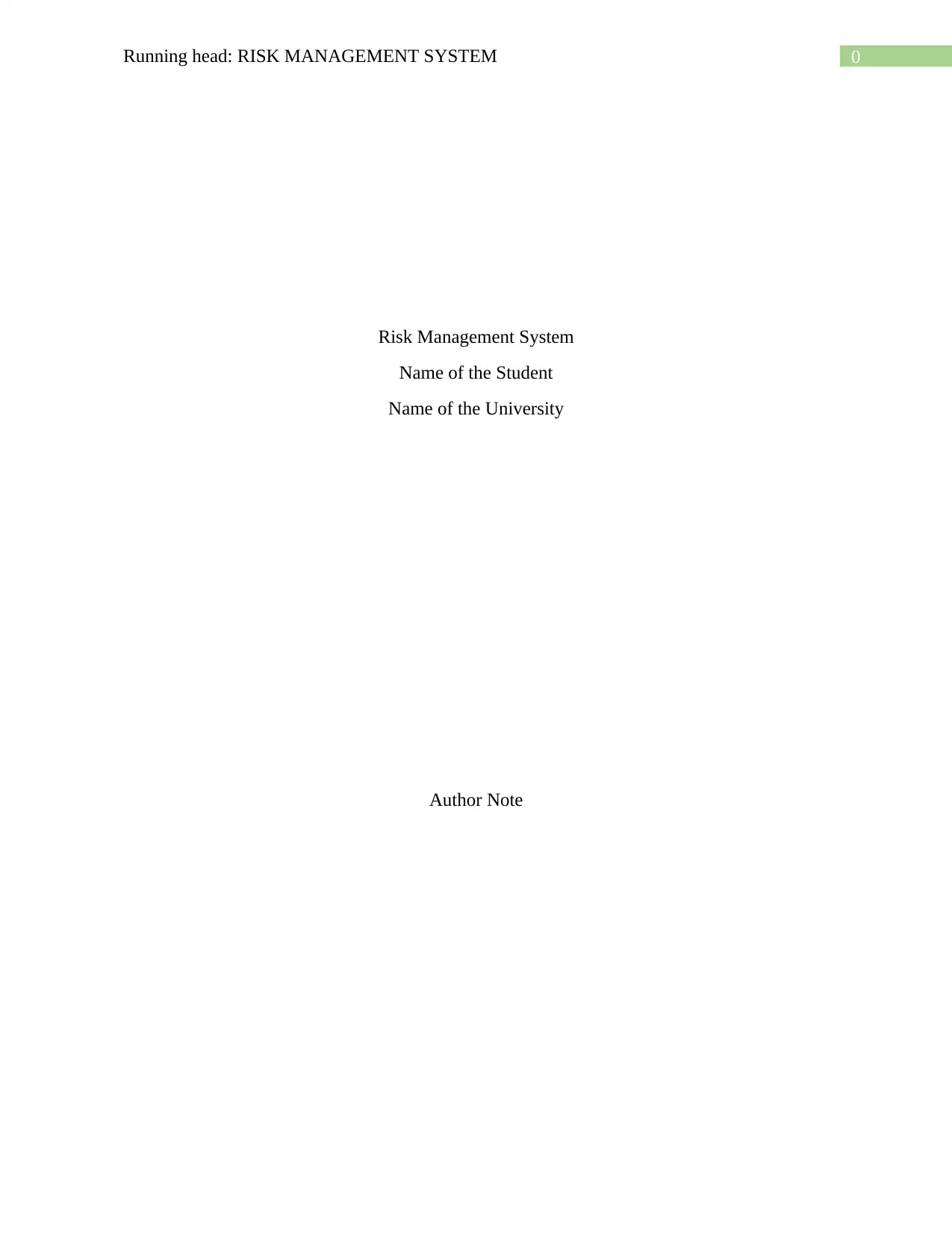
0Running head: RISK MANAGEMENT SYSTEM
Risk Management System
Name of the Student
Name of the University
Author Note
Risk Management System
Name of the Student
Name of the University
Author Note
Paraphrase This Document
Need a fresh take? Get an instant paraphrase of this document with our AI Paraphraser
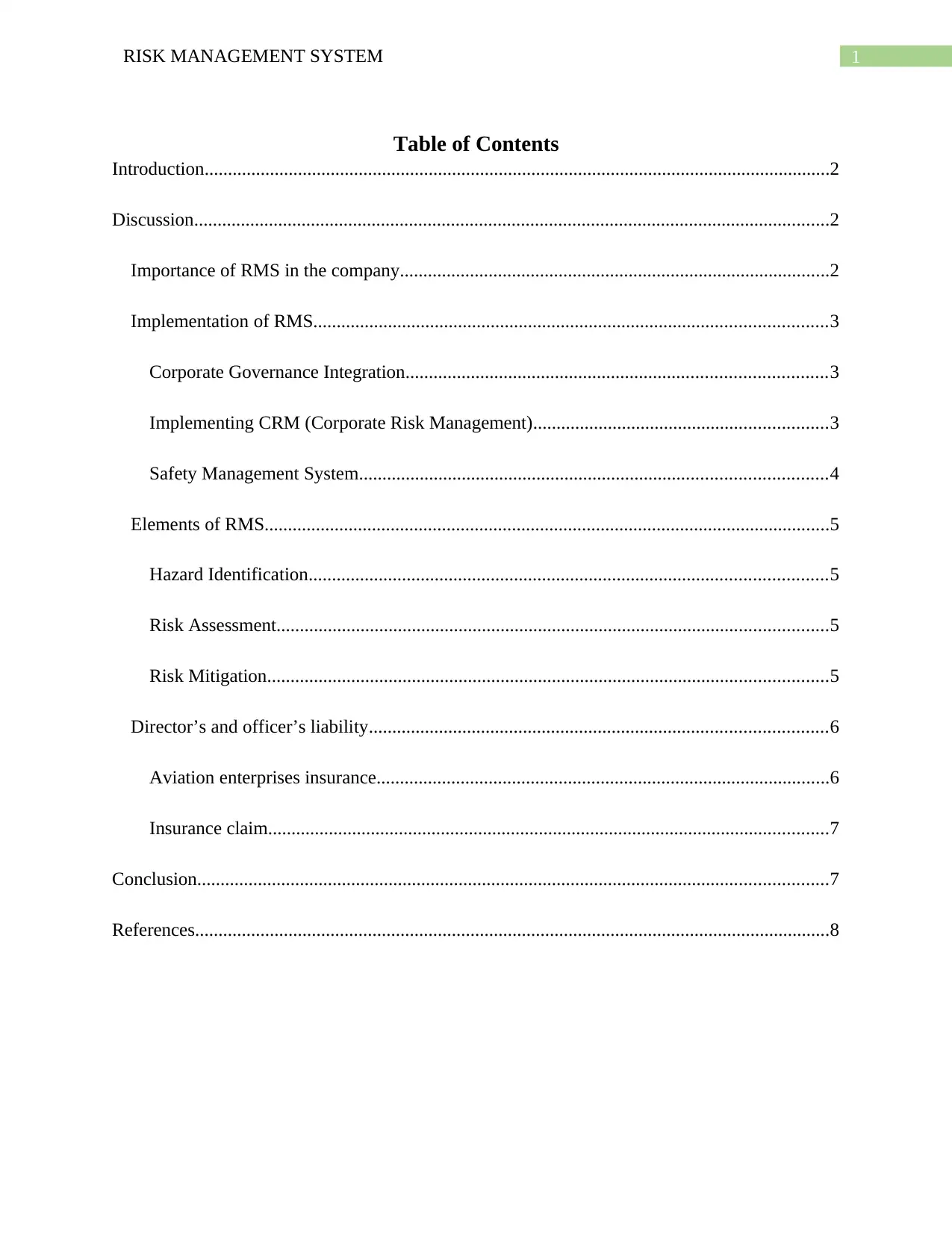
1RISK MANAGEMENT SYSTEM
Table of Contents
Introduction......................................................................................................................................2
Discussion........................................................................................................................................2
Importance of RMS in the company............................................................................................2
Implementation of RMS..............................................................................................................3
Corporate Governance Integration..........................................................................................3
Implementing CRM (Corporate Risk Management)...............................................................3
Safety Management System....................................................................................................4
Elements of RMS.........................................................................................................................5
Hazard Identification...............................................................................................................5
Risk Assessment......................................................................................................................5
Risk Mitigation........................................................................................................................5
Director’s and officer’s liability..................................................................................................6
Aviation enterprises insurance.................................................................................................6
Insurance claim........................................................................................................................7
Conclusion.......................................................................................................................................7
References........................................................................................................................................8
Table of Contents
Introduction......................................................................................................................................2
Discussion........................................................................................................................................2
Importance of RMS in the company............................................................................................2
Implementation of RMS..............................................................................................................3
Corporate Governance Integration..........................................................................................3
Implementing CRM (Corporate Risk Management)...............................................................3
Safety Management System....................................................................................................4
Elements of RMS.........................................................................................................................5
Hazard Identification...............................................................................................................5
Risk Assessment......................................................................................................................5
Risk Mitigation........................................................................................................................5
Director’s and officer’s liability..................................................................................................6
Aviation enterprises insurance.................................................................................................6
Insurance claim........................................................................................................................7
Conclusion.......................................................................................................................................7
References........................................................................................................................................8
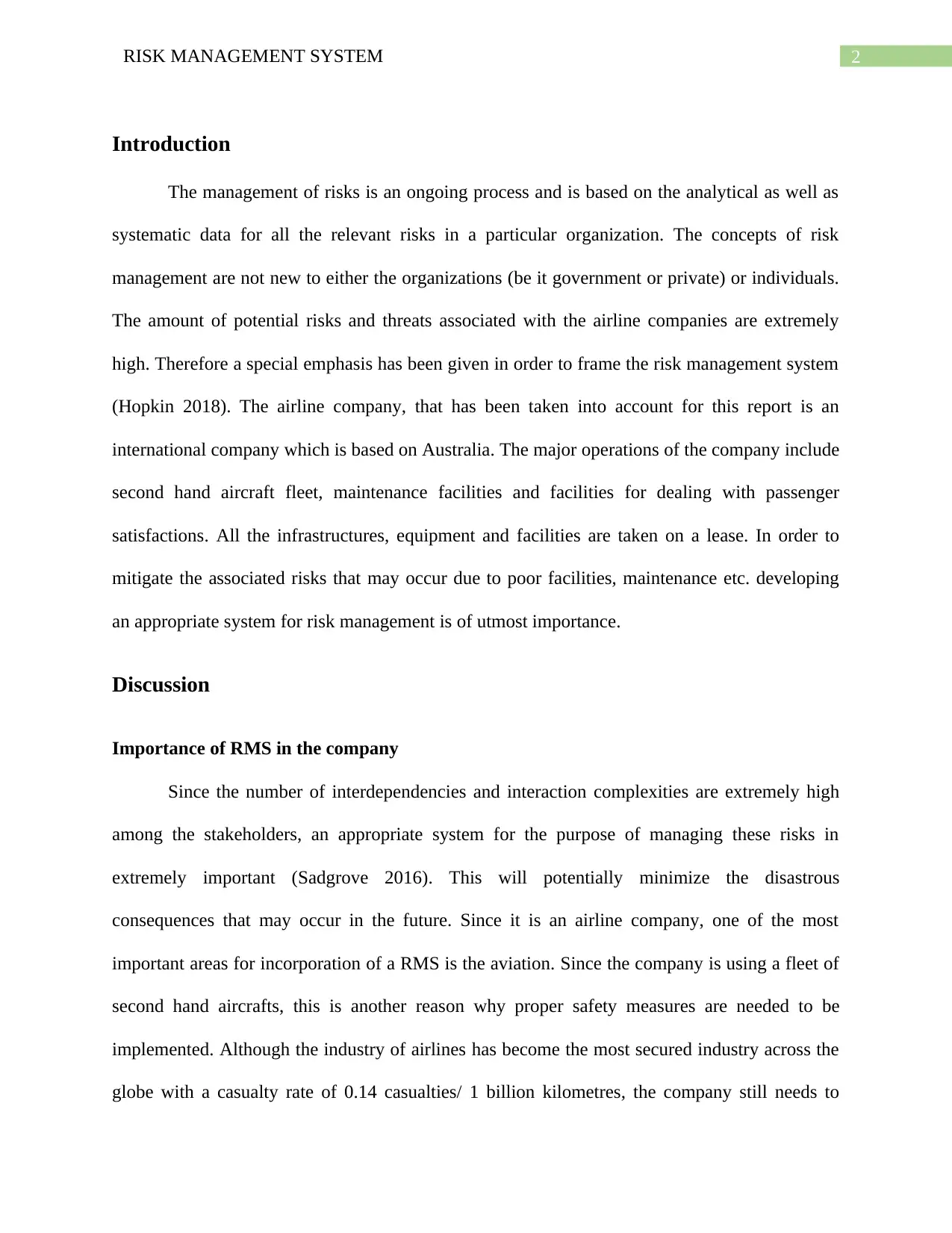
2RISK MANAGEMENT SYSTEM
Introduction
The management of risks is an ongoing process and is based on the analytical as well as
systematic data for all the relevant risks in a particular organization. The concepts of risk
management are not new to either the organizations (be it government or private) or individuals.
The amount of potential risks and threats associated with the airline companies are extremely
high. Therefore a special emphasis has been given in order to frame the risk management system
(Hopkin 2018). The airline company, that has been taken into account for this report is an
international company which is based on Australia. The major operations of the company include
second hand aircraft fleet, maintenance facilities and facilities for dealing with passenger
satisfactions. All the infrastructures, equipment and facilities are taken on a lease. In order to
mitigate the associated risks that may occur due to poor facilities, maintenance etc. developing
an appropriate system for risk management is of utmost importance.
Discussion
Importance of RMS in the company
Since the number of interdependencies and interaction complexities are extremely high
among the stakeholders, an appropriate system for the purpose of managing these risks in
extremely important (Sadgrove 2016). This will potentially minimize the disastrous
consequences that may occur in the future. Since it is an airline company, one of the most
important areas for incorporation of a RMS is the aviation. Since the company is using a fleet of
second hand aircrafts, this is another reason why proper safety measures are needed to be
implemented. Although the industry of airlines has become the most secured industry across the
globe with a casualty rate of 0.14 casualties/ 1 billion kilometres, the company still needs to
Introduction
The management of risks is an ongoing process and is based on the analytical as well as
systematic data for all the relevant risks in a particular organization. The concepts of risk
management are not new to either the organizations (be it government or private) or individuals.
The amount of potential risks and threats associated with the airline companies are extremely
high. Therefore a special emphasis has been given in order to frame the risk management system
(Hopkin 2018). The airline company, that has been taken into account for this report is an
international company which is based on Australia. The major operations of the company include
second hand aircraft fleet, maintenance facilities and facilities for dealing with passenger
satisfactions. All the infrastructures, equipment and facilities are taken on a lease. In order to
mitigate the associated risks that may occur due to poor facilities, maintenance etc. developing
an appropriate system for risk management is of utmost importance.
Discussion
Importance of RMS in the company
Since the number of interdependencies and interaction complexities are extremely high
among the stakeholders, an appropriate system for the purpose of managing these risks in
extremely important (Sadgrove 2016). This will potentially minimize the disastrous
consequences that may occur in the future. Since it is an airline company, one of the most
important areas for incorporation of a RMS is the aviation. Since the company is using a fleet of
second hand aircrafts, this is another reason why proper safety measures are needed to be
implemented. Although the industry of airlines has become the most secured industry across the
globe with a casualty rate of 0.14 casualties/ 1 billion kilometres, the company still needs to
⊘ This is a preview!⊘
Do you want full access?
Subscribe today to unlock all pages.

Trusted by 1+ million students worldwide
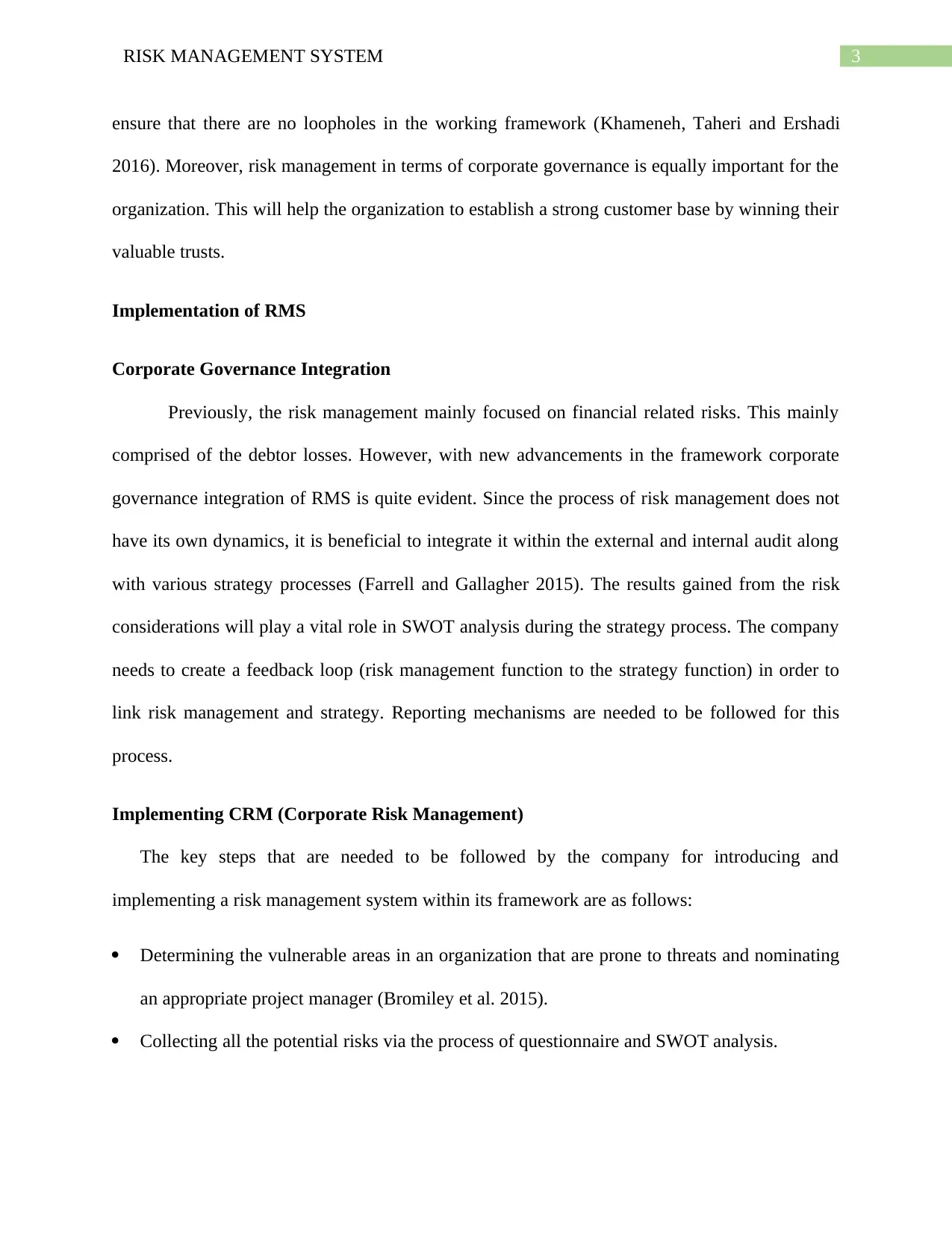
3RISK MANAGEMENT SYSTEM
ensure that there are no loopholes in the working framework (Khameneh, Taheri and Ershadi
2016). Moreover, risk management in terms of corporate governance is equally important for the
organization. This will help the organization to establish a strong customer base by winning their
valuable trusts.
Implementation of RMS
Corporate Governance Integration
Previously, the risk management mainly focused on financial related risks. This mainly
comprised of the debtor losses. However, with new advancements in the framework corporate
governance integration of RMS is quite evident. Since the process of risk management does not
have its own dynamics, it is beneficial to integrate it within the external and internal audit along
with various strategy processes (Farrell and Gallagher 2015). The results gained from the risk
considerations will play a vital role in SWOT analysis during the strategy process. The company
needs to create a feedback loop (risk management function to the strategy function) in order to
link risk management and strategy. Reporting mechanisms are needed to be followed for this
process.
Implementing CRM (Corporate Risk Management)
The key steps that are needed to be followed by the company for introducing and
implementing a risk management system within its framework are as follows:
Determining the vulnerable areas in an organization that are prone to threats and nominating
an appropriate project manager (Bromiley et al. 2015).
Collecting all the potential risks via the process of questionnaire and SWOT analysis.
ensure that there are no loopholes in the working framework (Khameneh, Taheri and Ershadi
2016). Moreover, risk management in terms of corporate governance is equally important for the
organization. This will help the organization to establish a strong customer base by winning their
valuable trusts.
Implementation of RMS
Corporate Governance Integration
Previously, the risk management mainly focused on financial related risks. This mainly
comprised of the debtor losses. However, with new advancements in the framework corporate
governance integration of RMS is quite evident. Since the process of risk management does not
have its own dynamics, it is beneficial to integrate it within the external and internal audit along
with various strategy processes (Farrell and Gallagher 2015). The results gained from the risk
considerations will play a vital role in SWOT analysis during the strategy process. The company
needs to create a feedback loop (risk management function to the strategy function) in order to
link risk management and strategy. Reporting mechanisms are needed to be followed for this
process.
Implementing CRM (Corporate Risk Management)
The key steps that are needed to be followed by the company for introducing and
implementing a risk management system within its framework are as follows:
Determining the vulnerable areas in an organization that are prone to threats and nominating
an appropriate project manager (Bromiley et al. 2015).
Collecting all the potential risks via the process of questionnaire and SWOT analysis.
Paraphrase This Document
Need a fresh take? Get an instant paraphrase of this document with our AI Paraphraser
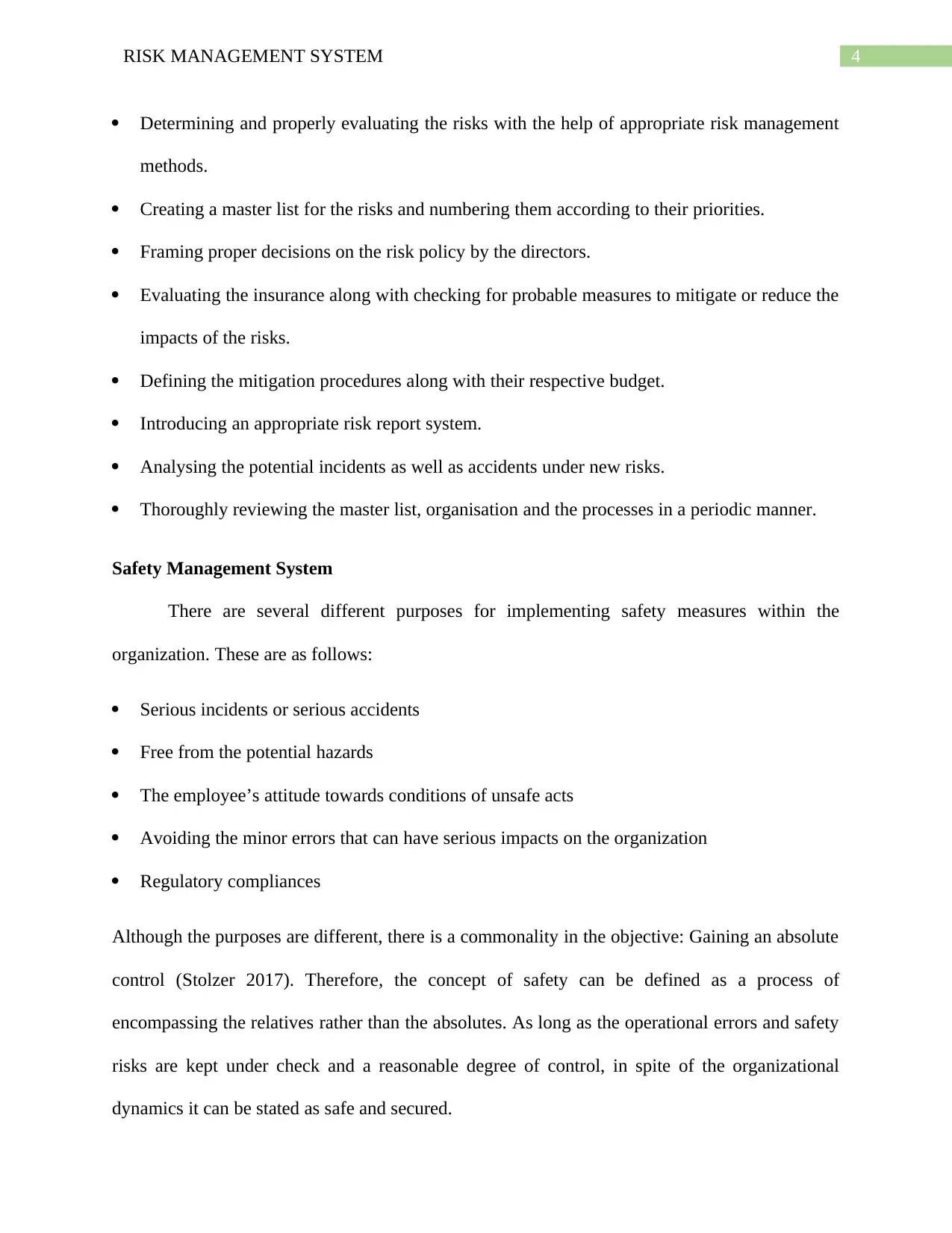
4RISK MANAGEMENT SYSTEM
Determining and properly evaluating the risks with the help of appropriate risk management
methods.
Creating a master list for the risks and numbering them according to their priorities.
Framing proper decisions on the risk policy by the directors.
Evaluating the insurance along with checking for probable measures to mitigate or reduce the
impacts of the risks.
Defining the mitigation procedures along with their respective budget.
Introducing an appropriate risk report system.
Analysing the potential incidents as well as accidents under new risks.
Thoroughly reviewing the master list, organisation and the processes in a periodic manner.
Safety Management System
There are several different purposes for implementing safety measures within the
organization. These are as follows:
Serious incidents or serious accidents
Free from the potential hazards
The employee’s attitude towards conditions of unsafe acts
Avoiding the minor errors that can have serious impacts on the organization
Regulatory compliances
Although the purposes are different, there is a commonality in the objective: Gaining an absolute
control (Stolzer 2017). Therefore, the concept of safety can be defined as a process of
encompassing the relatives rather than the absolutes. As long as the operational errors and safety
risks are kept under check and a reasonable degree of control, in spite of the organizational
dynamics it can be stated as safe and secured.
Determining and properly evaluating the risks with the help of appropriate risk management
methods.
Creating a master list for the risks and numbering them according to their priorities.
Framing proper decisions on the risk policy by the directors.
Evaluating the insurance along with checking for probable measures to mitigate or reduce the
impacts of the risks.
Defining the mitigation procedures along with their respective budget.
Introducing an appropriate risk report system.
Analysing the potential incidents as well as accidents under new risks.
Thoroughly reviewing the master list, organisation and the processes in a periodic manner.
Safety Management System
There are several different purposes for implementing safety measures within the
organization. These are as follows:
Serious incidents or serious accidents
Free from the potential hazards
The employee’s attitude towards conditions of unsafe acts
Avoiding the minor errors that can have serious impacts on the organization
Regulatory compliances
Although the purposes are different, there is a commonality in the objective: Gaining an absolute
control (Stolzer 2017). Therefore, the concept of safety can be defined as a process of
encompassing the relatives rather than the absolutes. As long as the operational errors and safety
risks are kept under check and a reasonable degree of control, in spite of the organizational
dynamics it can be stated as safe and secured.
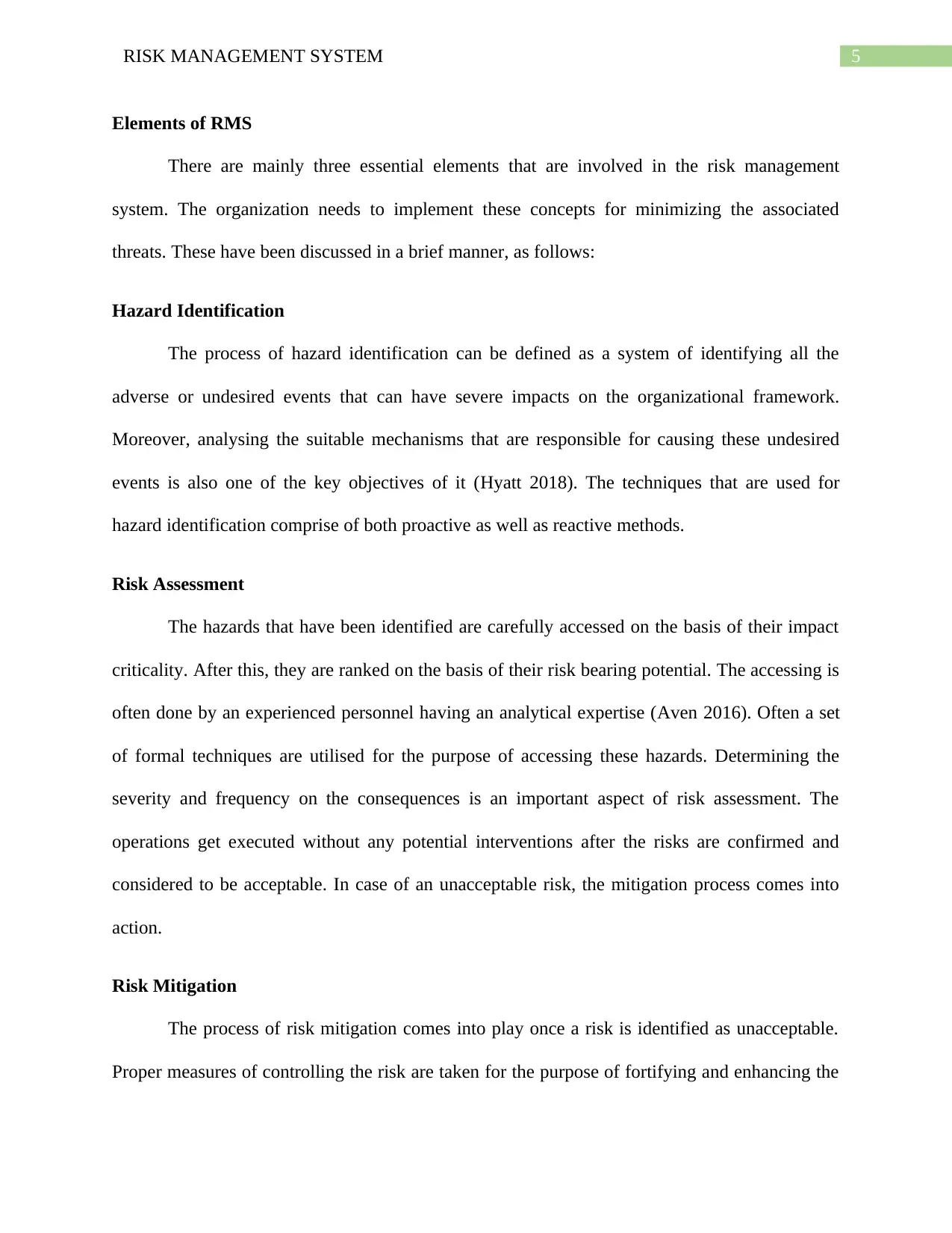
5RISK MANAGEMENT SYSTEM
Elements of RMS
There are mainly three essential elements that are involved in the risk management
system. The organization needs to implement these concepts for minimizing the associated
threats. These have been discussed in a brief manner, as follows:
Hazard Identification
The process of hazard identification can be defined as a system of identifying all the
adverse or undesired events that can have severe impacts on the organizational framework.
Moreover, analysing the suitable mechanisms that are responsible for causing these undesired
events is also one of the key objectives of it (Hyatt 2018). The techniques that are used for
hazard identification comprise of both proactive as well as reactive methods.
Risk Assessment
The hazards that have been identified are carefully accessed on the basis of their impact
criticality. After this, they are ranked on the basis of their risk bearing potential. The accessing is
often done by an experienced personnel having an analytical expertise (Aven 2016). Often a set
of formal techniques are utilised for the purpose of accessing these hazards. Determining the
severity and frequency on the consequences is an important aspect of risk assessment. The
operations get executed without any potential interventions after the risks are confirmed and
considered to be acceptable. In case of an unacceptable risk, the mitigation process comes into
action.
Risk Mitigation
The process of risk mitigation comes into play once a risk is identified as unacceptable.
Proper measures of controlling the risk are taken for the purpose of fortifying and enhancing the
Elements of RMS
There are mainly three essential elements that are involved in the risk management
system. The organization needs to implement these concepts for minimizing the associated
threats. These have been discussed in a brief manner, as follows:
Hazard Identification
The process of hazard identification can be defined as a system of identifying all the
adverse or undesired events that can have severe impacts on the organizational framework.
Moreover, analysing the suitable mechanisms that are responsible for causing these undesired
events is also one of the key objectives of it (Hyatt 2018). The techniques that are used for
hazard identification comprise of both proactive as well as reactive methods.
Risk Assessment
The hazards that have been identified are carefully accessed on the basis of their impact
criticality. After this, they are ranked on the basis of their risk bearing potential. The accessing is
often done by an experienced personnel having an analytical expertise (Aven 2016). Often a set
of formal techniques are utilised for the purpose of accessing these hazards. Determining the
severity and frequency on the consequences is an important aspect of risk assessment. The
operations get executed without any potential interventions after the risks are confirmed and
considered to be acceptable. In case of an unacceptable risk, the mitigation process comes into
action.
Risk Mitigation
The process of risk mitigation comes into play once a risk is identified as unacceptable.
Proper measures of controlling the risk are taken for the purpose of fortifying and enhancing the
⊘ This is a preview!⊘
Do you want full access?
Subscribe today to unlock all pages.

Trusted by 1+ million students worldwide
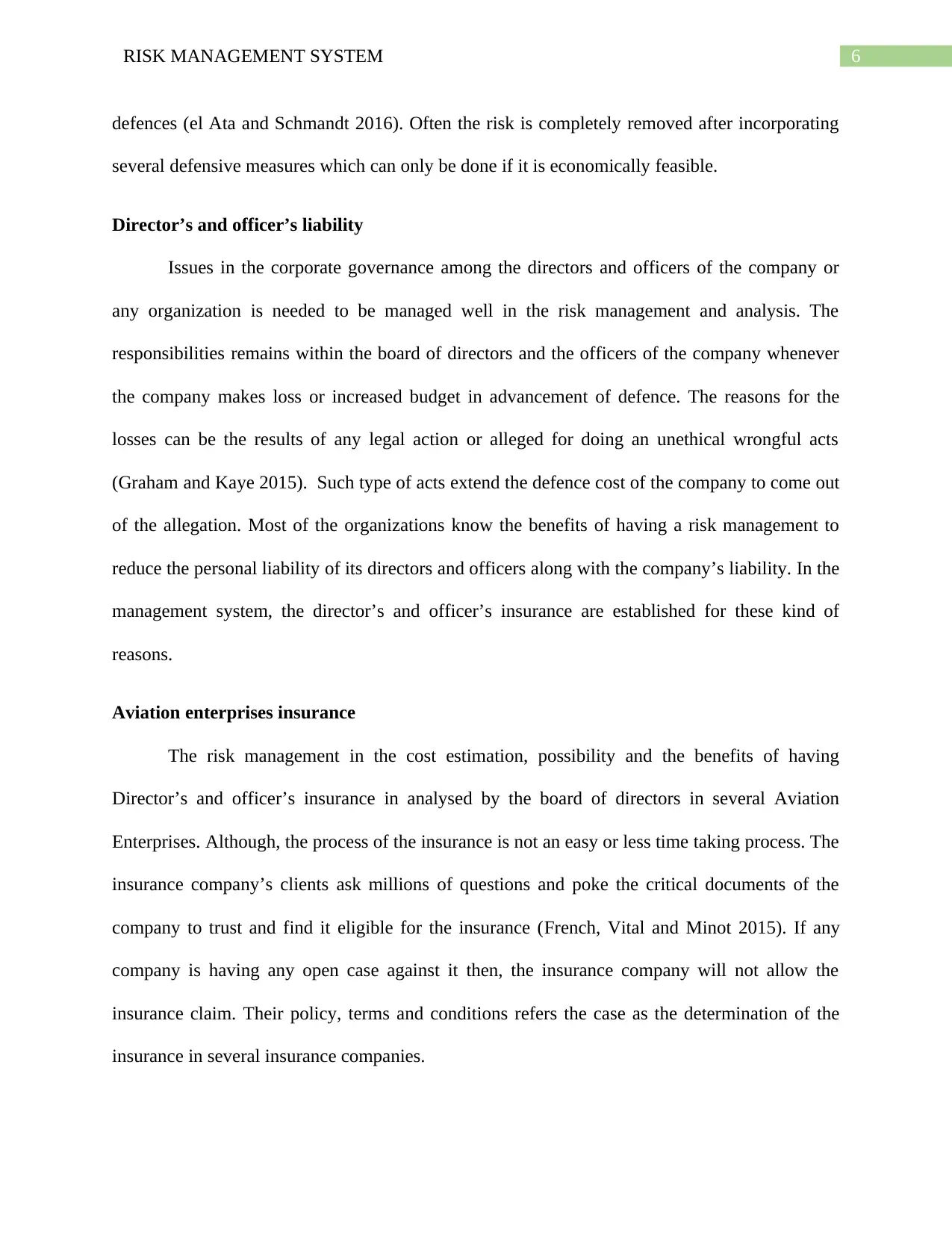
6RISK MANAGEMENT SYSTEM
defences (el Ata and Schmandt 2016). Often the risk is completely removed after incorporating
several defensive measures which can only be done if it is economically feasible.
Director’s and officer’s liability
Issues in the corporate governance among the directors and officers of the company or
any organization is needed to be managed well in the risk management and analysis. The
responsibilities remains within the board of directors and the officers of the company whenever
the company makes loss or increased budget in advancement of defence. The reasons for the
losses can be the results of any legal action or alleged for doing an unethical wrongful acts
(Graham and Kaye 2015). Such type of acts extend the defence cost of the company to come out
of the allegation. Most of the organizations know the benefits of having a risk management to
reduce the personal liability of its directors and officers along with the company’s liability. In the
management system, the director’s and officer’s insurance are established for these kind of
reasons.
Aviation enterprises insurance
The risk management in the cost estimation, possibility and the benefits of having
Director’s and officer’s insurance in analysed by the board of directors in several Aviation
Enterprises. Although, the process of the insurance is not an easy or less time taking process. The
insurance company’s clients ask millions of questions and poke the critical documents of the
company to trust and find it eligible for the insurance (French, Vital and Minot 2015). If any
company is having any open case against it then, the insurance company will not allow the
insurance claim. Their policy, terms and conditions refers the case as the determination of the
insurance in several insurance companies.
defences (el Ata and Schmandt 2016). Often the risk is completely removed after incorporating
several defensive measures which can only be done if it is economically feasible.
Director’s and officer’s liability
Issues in the corporate governance among the directors and officers of the company or
any organization is needed to be managed well in the risk management and analysis. The
responsibilities remains within the board of directors and the officers of the company whenever
the company makes loss or increased budget in advancement of defence. The reasons for the
losses can be the results of any legal action or alleged for doing an unethical wrongful acts
(Graham and Kaye 2015). Such type of acts extend the defence cost of the company to come out
of the allegation. Most of the organizations know the benefits of having a risk management to
reduce the personal liability of its directors and officers along with the company’s liability. In the
management system, the director’s and officer’s insurance are established for these kind of
reasons.
Aviation enterprises insurance
The risk management in the cost estimation, possibility and the benefits of having
Director’s and officer’s insurance in analysed by the board of directors in several Aviation
Enterprises. Although, the process of the insurance is not an easy or less time taking process. The
insurance company’s clients ask millions of questions and poke the critical documents of the
company to trust and find it eligible for the insurance (French, Vital and Minot 2015). If any
company is having any open case against it then, the insurance company will not allow the
insurance claim. Their policy, terms and conditions refers the case as the determination of the
insurance in several insurance companies.
Paraphrase This Document
Need a fresh take? Get an instant paraphrase of this document with our AI Paraphraser
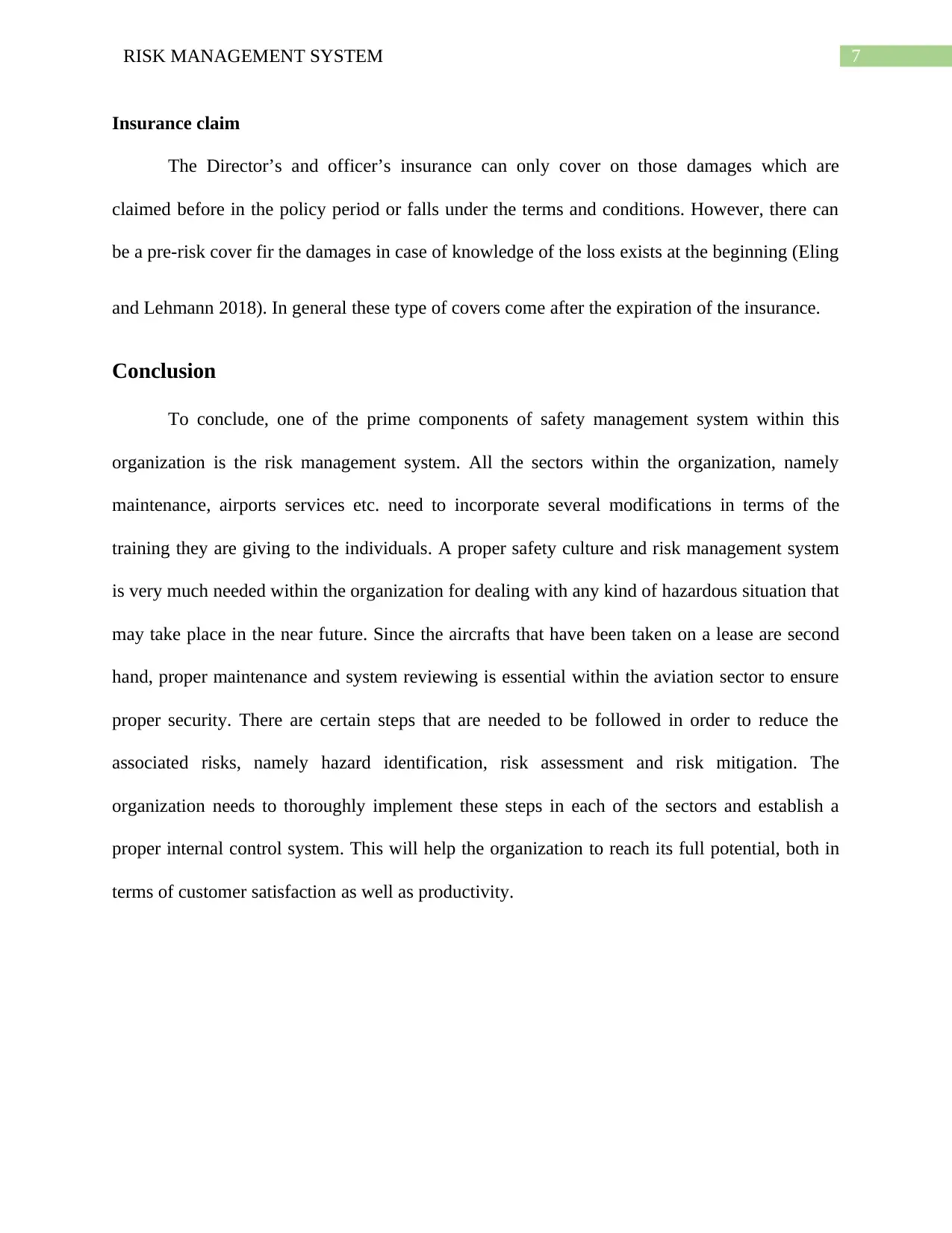
7RISK MANAGEMENT SYSTEM
Insurance claim
The Director’s and officer’s insurance can only cover on those damages which are
claimed before in the policy period or falls under the terms and conditions. However, there can
be a pre-risk cover fir the damages in case of knowledge of the loss exists at the beginning (Eling
and Lehmann 2018). In general these type of covers come after the expiration of the insurance.
Conclusion
To conclude, one of the prime components of safety management system within this
organization is the risk management system. All the sectors within the organization, namely
maintenance, airports services etc. need to incorporate several modifications in terms of the
training they are giving to the individuals. A proper safety culture and risk management system
is very much needed within the organization for dealing with any kind of hazardous situation that
may take place in the near future. Since the aircrafts that have been taken on a lease are second
hand, proper maintenance and system reviewing is essential within the aviation sector to ensure
proper security. There are certain steps that are needed to be followed in order to reduce the
associated risks, namely hazard identification, risk assessment and risk mitigation. The
organization needs to thoroughly implement these steps in each of the sectors and establish a
proper internal control system. This will help the organization to reach its full potential, both in
terms of customer satisfaction as well as productivity.
Insurance claim
The Director’s and officer’s insurance can only cover on those damages which are
claimed before in the policy period or falls under the terms and conditions. However, there can
be a pre-risk cover fir the damages in case of knowledge of the loss exists at the beginning (Eling
and Lehmann 2018). In general these type of covers come after the expiration of the insurance.
Conclusion
To conclude, one of the prime components of safety management system within this
organization is the risk management system. All the sectors within the organization, namely
maintenance, airports services etc. need to incorporate several modifications in terms of the
training they are giving to the individuals. A proper safety culture and risk management system
is very much needed within the organization for dealing with any kind of hazardous situation that
may take place in the near future. Since the aircrafts that have been taken on a lease are second
hand, proper maintenance and system reviewing is essential within the aviation sector to ensure
proper security. There are certain steps that are needed to be followed in order to reduce the
associated risks, namely hazard identification, risk assessment and risk mitigation. The
organization needs to thoroughly implement these steps in each of the sectors and establish a
proper internal control system. This will help the organization to reach its full potential, both in
terms of customer satisfaction as well as productivity.
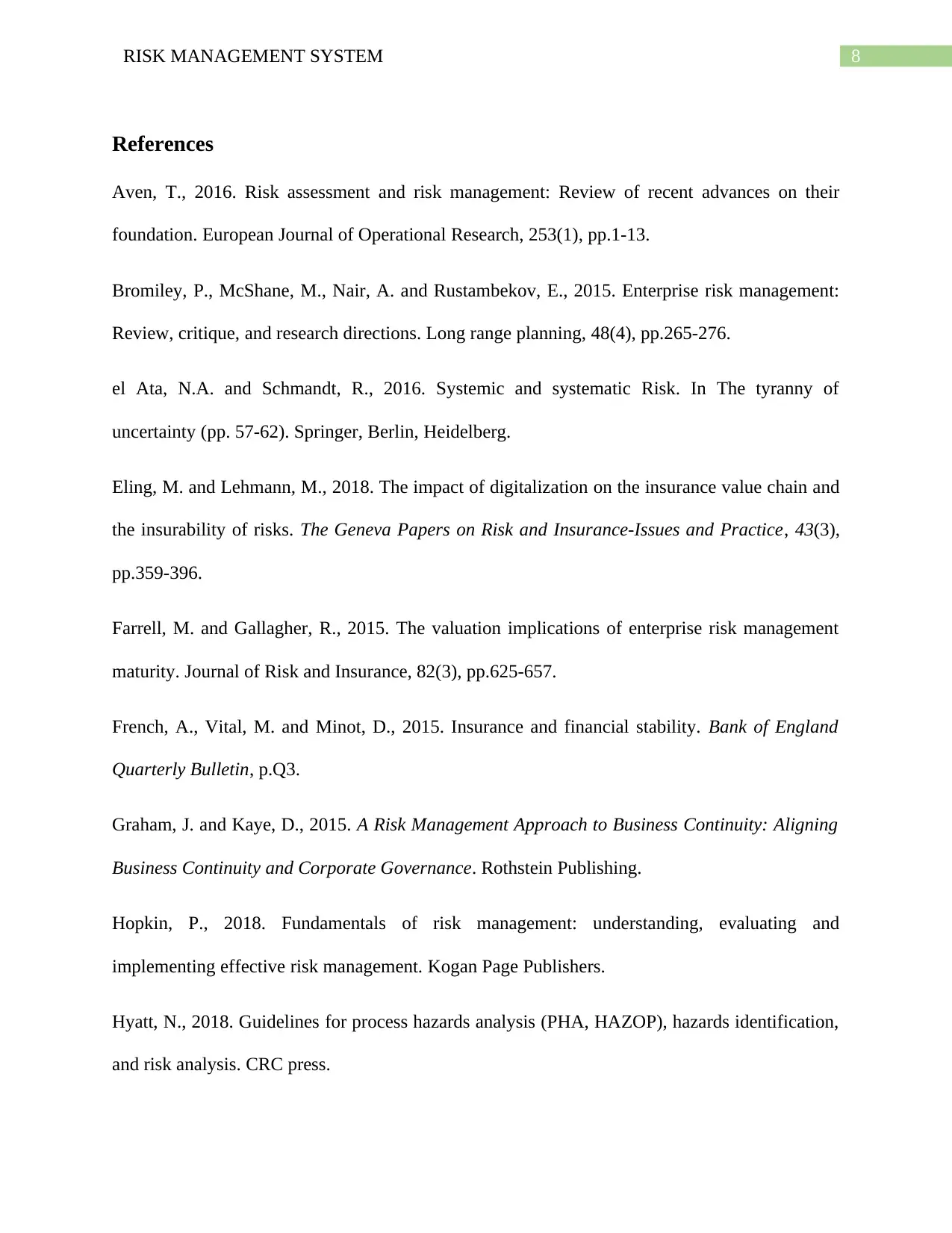
8RISK MANAGEMENT SYSTEM
References
Aven, T., 2016. Risk assessment and risk management: Review of recent advances on their
foundation. European Journal of Operational Research, 253(1), pp.1-13.
Bromiley, P., McShane, M., Nair, A. and Rustambekov, E., 2015. Enterprise risk management:
Review, critique, and research directions. Long range planning, 48(4), pp.265-276.
el Ata, N.A. and Schmandt, R., 2016. Systemic and systematic Risk. In The tyranny of
uncertainty (pp. 57-62). Springer, Berlin, Heidelberg.
Eling, M. and Lehmann, M., 2018. The impact of digitalization on the insurance value chain and
the insurability of risks. The Geneva Papers on Risk and Insurance-Issues and Practice, 43(3),
pp.359-396.
Farrell, M. and Gallagher, R., 2015. The valuation implications of enterprise risk management
maturity. Journal of Risk and Insurance, 82(3), pp.625-657.
French, A., Vital, M. and Minot, D., 2015. Insurance and financial stability. Bank of England
Quarterly Bulletin, p.Q3.
Graham, J. and Kaye, D., 2015. A Risk Management Approach to Business Continuity: Aligning
Business Continuity and Corporate Governance. Rothstein Publishing.
Hopkin, P., 2018. Fundamentals of risk management: understanding, evaluating and
implementing effective risk management. Kogan Page Publishers.
Hyatt, N., 2018. Guidelines for process hazards analysis (PHA, HAZOP), hazards identification,
and risk analysis. CRC press.
References
Aven, T., 2016. Risk assessment and risk management: Review of recent advances on their
foundation. European Journal of Operational Research, 253(1), pp.1-13.
Bromiley, P., McShane, M., Nair, A. and Rustambekov, E., 2015. Enterprise risk management:
Review, critique, and research directions. Long range planning, 48(4), pp.265-276.
el Ata, N.A. and Schmandt, R., 2016. Systemic and systematic Risk. In The tyranny of
uncertainty (pp. 57-62). Springer, Berlin, Heidelberg.
Eling, M. and Lehmann, M., 2018. The impact of digitalization on the insurance value chain and
the insurability of risks. The Geneva Papers on Risk and Insurance-Issues and Practice, 43(3),
pp.359-396.
Farrell, M. and Gallagher, R., 2015. The valuation implications of enterprise risk management
maturity. Journal of Risk and Insurance, 82(3), pp.625-657.
French, A., Vital, M. and Minot, D., 2015. Insurance and financial stability. Bank of England
Quarterly Bulletin, p.Q3.
Graham, J. and Kaye, D., 2015. A Risk Management Approach to Business Continuity: Aligning
Business Continuity and Corporate Governance. Rothstein Publishing.
Hopkin, P., 2018. Fundamentals of risk management: understanding, evaluating and
implementing effective risk management. Kogan Page Publishers.
Hyatt, N., 2018. Guidelines for process hazards analysis (PHA, HAZOP), hazards identification,
and risk analysis. CRC press.
⊘ This is a preview!⊘
Do you want full access?
Subscribe today to unlock all pages.

Trusted by 1+ million students worldwide
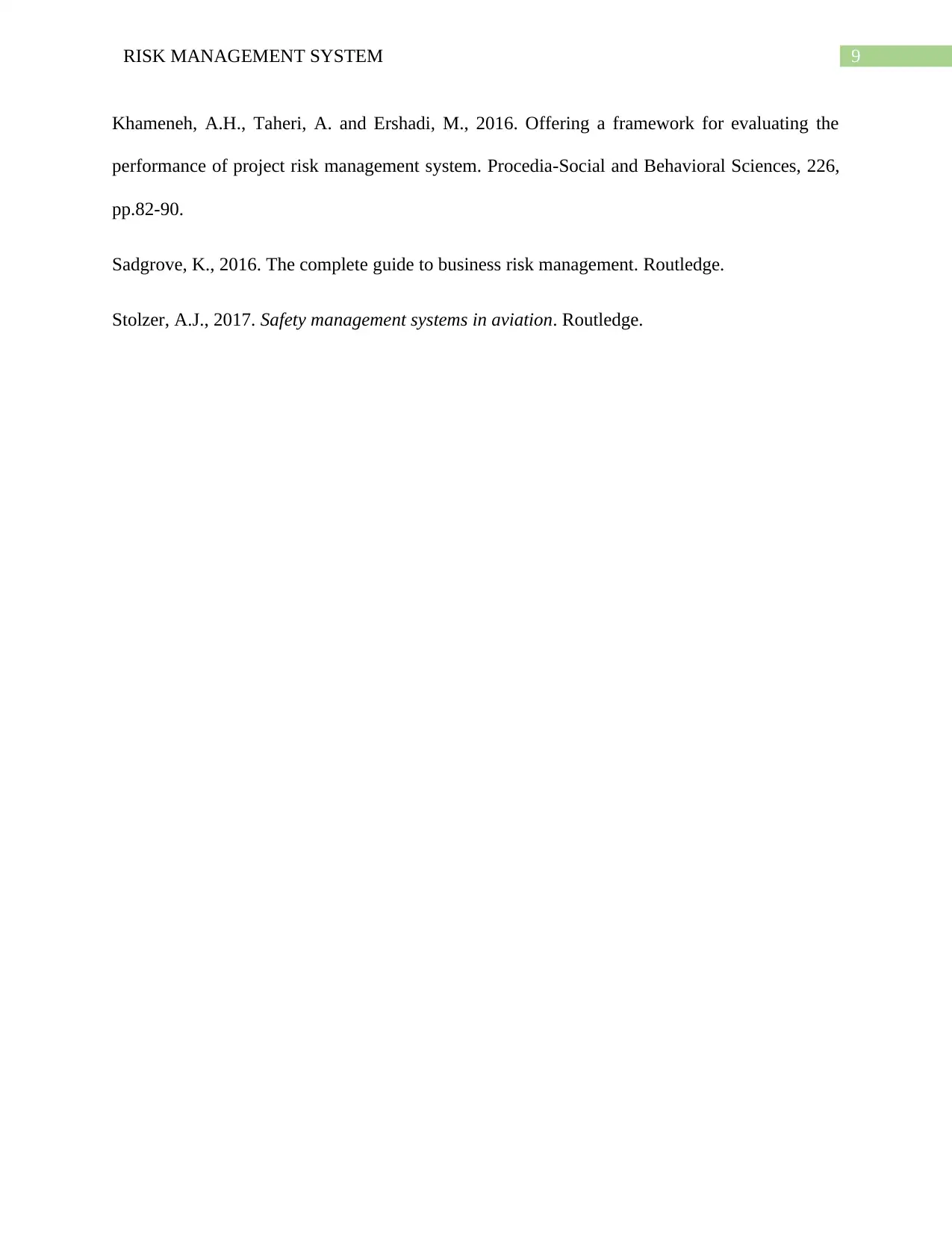
9RISK MANAGEMENT SYSTEM
Khameneh, A.H., Taheri, A. and Ershadi, M., 2016. Offering a framework for evaluating the
performance of project risk management system. Procedia-Social and Behavioral Sciences, 226,
pp.82-90.
Sadgrove, K., 2016. The complete guide to business risk management. Routledge.
Stolzer, A.J., 2017. Safety management systems in aviation. Routledge.
Khameneh, A.H., Taheri, A. and Ershadi, M., 2016. Offering a framework for evaluating the
performance of project risk management system. Procedia-Social and Behavioral Sciences, 226,
pp.82-90.
Sadgrove, K., 2016. The complete guide to business risk management. Routledge.
Stolzer, A.J., 2017. Safety management systems in aviation. Routledge.
1 out of 10
Related Documents
Your All-in-One AI-Powered Toolkit for Academic Success.
+13062052269
info@desklib.com
Available 24*7 on WhatsApp / Email
![[object Object]](/_next/static/media/star-bottom.7253800d.svg)
Unlock your academic potential
Copyright © 2020–2025 A2Z Services. All Rights Reserved. Developed and managed by ZUCOL.




